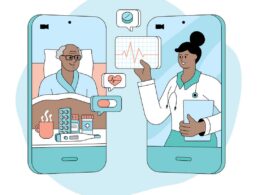New England Journal of Medicine (NEJM)
Julia Adler-Milstein, Ph.D., and Ateev Mehrotra, M.D.
September 2, 2021
N Engl J Med 2021; 385:871–873
The Covid-19 pandemic has driven a dramatic expansion of digital patient care interactions. Video telemedicine visits have received the most attention, but equally notable is the expanded use of other “touchpoints,” ranging from phone calls to portal messages to the sharing of remote-monitoring data. In the United States, the number of telemedicine visits increased by a factor of 38 and the number of messages sent on patient portals increased by more than 40% in the spring of 2020, as compared with prepandemic levels.1
Although this shift was motivated by necessity, it’s clear that neither patients nor physicians want to go back to a world in which in-person visits are the only form of care delivery.
Instead, they want the ability to choose among various options on the continuum of modes of interaction — from in-person visits to video visits to asynchronous messages — to select the mode that best fits their clinical needs and personal preferences.
The current U.S. fee-for-service payment system is an important obstacle to achieving this vision, however.
This model essentially forces physicians to choose between returning to the world of in-person visits and navigating overly complex rules to determine which digital services are reimbursable and what the reimbursements will be. Already, some health care systems are pushing their clinicians to return nearly entirely to in-person visits because of these challenges.
After a massive, decade-long investment in information technology,2 providing digital health care is technically feasible, but patients and physicians can’t reap the benefits because payers don’t know how best to pay for new digital health options.
There are several potential benefits of the choice of varied digital touchpoints.
- Choosing telemedicine instead of an in-person visit, or asynchronous messages instead of any visit, offers improved convenience for patients, with after-hours availability and reduced (or eliminated) travel time.
- Interactions that are more frequent but shorter than traditional visits, such as weekly check-ins using telemedicine or portal messaging, may result in better outcomes for patients with chronic illnesses, including reductions in avoidable hospitalizations.
- This model might also improve productivity by allowing a single physician to effectively care for more patients, thereby increasing access to primary and specialty care.
Yet society will fail to realize these benefits if payment systems continue to reimburse for units of care.
Indeed, although much of the current debate surrounding digitally enabled care relates to paying for video telemedicine visits, patients and clinicians may prefer telephone calls or portal messages — interactions for which physicians weren’t reimbursed before the pandemic.3
In an effort to recoup income, clinicians (or their health care systems) may modify the ways in which they offer care to ensure that they are reimbursed.
- Previously free telephone calls for medical advice are now billed as audio-only telemedicine visits.
- Previously free portal messages are now billed as e-visits, which are defined as patient-initiated asynchronous contact for a new, acute problem.
- Instead of occasionally messaging their physician with information about blood-pressure measurements, patients may be encouraged to use blood-pressure monitors that automatically send measurements to permit billing for remote patient monitoring.
Although billing for more units of (digital) care will increase clinical revenue, such a shift could have substantial negative consequences.
- Administrative costs will increase because of the increased number of bills submitted and, more important, because of complex billing requirements and related documentation.
For example, an e-visit can be billed to Medicare only if the visit was initiated by the patient, patient consent was obtained, and a clinical decision was made.
A clinician billing for remote patient monitoring (Current Procedural Terminology code 99457) must receive at least 16 days’ worth of patient-reported data in a given calendar month and must spend at least 20 minutes interpreting and acting on these data. When the units become smaller and smaller (e.g., it may take a clinician only 2 minutes to respond to a portal message), the estimated $20 of administrative costs required to submit a bill for a single patient encounter may not be worth it. - Furthermore, because it’s hard to set accurate prices for various services, health care organizations will inevitably encourage interactions for which they receive higher payments, thereby increasing health care spending.
Fundamentally, using billing rules and regulations to determine when one form of interaction should be used instead of another feels administratively impossible — and clinicians and patients will find such determinations absurd.
If a previously free portal message is now considered an e-visit, many patients will have higher out-of-pocket costs and will probably resent having to pay for something that was once free.
Health care systems face the daunting task of explaining to their patients which services are free and which will result in a bill, a process that will be further complicated by differences among payers.
Without payment-system changes, we can expect to have many unhappy patients and physicians struggling with this complex payment labyrinth. Only a payment system that encompasses some form of capitation will eliminate these issues.
Only a payment system that encompasses some form of capitation will eliminate these issues.
Notably, many new, virtual companies that provide care for various conditions, such as diabetes, mental illness, or opioid use disorder, are paid primarily by means of monthly capitated fees.
These companies know that fee-for-service payment is incompatible with clinical models that offer patients a range of ways to interact.
The attraction for both patients and physicians is clear: they can focus only on what makes sense clinically and practically.
Even under alternative payment models such as accountable care organizations, administrative and documentation barriers exist because these models are built on a fee-for-service “chassis” and still require clinicians to submit bills for each unit of care.
Numerous complexities would be involved in a shift to capitation. There are many options for capitation systems, including hybrid models that combine capitation and fee-for-service payment, as well as issues surrounding risk adjustment, ideal timing for payments (e.g., monthly vs. multiyear contracts), and whether primary care capitated payments should be extended to specialists and stand-alone telemedicine providers.4
Finding the specific model that supports optimal use of digital touchpoints would require substantial experimentation by private insurers and government payers, such as Medicare (for which experiments could be run through the Center for Medicare and Medicaid Innovation).
As part of this experimentation, fee-for-service payments might be a necessary bridge to maintain use of digital touchpoints.
In evaluating the effects of any new payment system, it will also be critical to assess equity-related concerns, especially if patients are asked to pay recurring fees for digital interactions.
Low-income patients may be less able than higher-income patients to afford fees and less likely to have the technology and digital literacy required to take advantage of these options.
Research suggests that these barriers can be overcome, however, and that disadvantaged populations use digital tools when given the opportunity.5
Although these challenges aren’t trivial, we believe that the status quo isn’t viable; the current approach that relies on determining payments for each type of digital interaction is destined to fail because such interactions aren’t distinct services that can be easily differentiated.
Unless we move rapidly toward capitated models, the health care system will continue to deliver suboptimal, non–patient-centered care that fails to harness the potential of the technology that exists all around us.
Author Affiliations
From the Center for Clinical Informatics and Improvement Research, University of California, San Francisco (J.A.M.), and Harvard Medical School, Boston (A.M.).
References (5)
- Mehrotra A. Looking ahead: what should the telemedicine regulatory and payment landscape look like after the pandemic? Washington, D.C.: Committee on Ways and Means, Subcommittee on Health, United States House of Representatives, April 28, 2021 (https://waysandmeans.house.gov/sites/democrats.waysandmeans.house.gov/files/documents/Ateev%20Mehrotra%20Testimony.pdf. opens in new tab).
- Washington V, DeSalvo K, Mostashari F, Blumenthal D. The HITECH era and the path forward. N Engl J Med 2017;377:904–906.
- Fischer SH, Ray KN, Mehrotra A, Bloom EL, Uscher-Pines L. Prevalence and characteristics of telehealth utilization in the United States. JAMA Netw Open 2020;3:e2022302-e2022302.
- 4.Implementing high-quality primary care: rebuilding the foundation of health care. National Academy of Medicine, May 2021 (https://www.nap.edu/resource/25983/High%20Quality%20Primary%20Care%20Policy%20Brief%201%20Payment.pdf. opens in new tab).
- Schickedanz A, Huang D, Lopez A, et al. Access, interest, and attitudes toward electronic communication for health care among patients in the medical safety net. J Gen Intern Med 2013;28:914–920.
Originally published at https://www.nejm.org.
This article was published on August 28, 2021, at NEJM.org.












